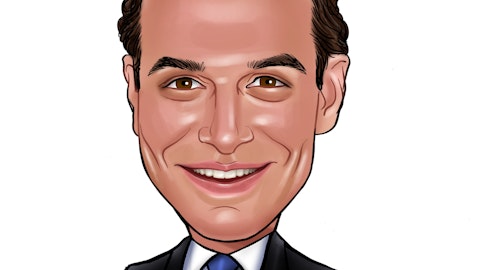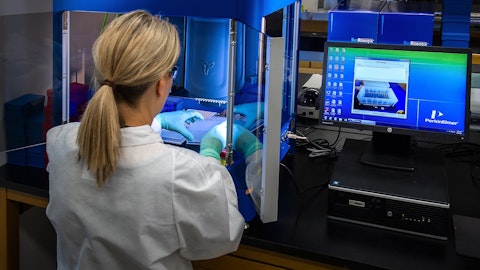Gary Nachman : Yes. No, I mean that’s helpful. But as far as potential co-promotes and then you said other types of selling alternatives for chronic sinusitis. And if you’re not going to change the size of the footprint, then there’s other ways that you’d be able to tap into that larger market, I presume.
Ramy Mahmoud : Well, so Gary, here’s — the way we’re thinking about this is that there’s a substantially increased potential within our current specialty audience. And that’s what I was talking about before. But as you said, there’s a lot of potential outside of our current specialty audience also. And we have to think creatively about the ways in which our Company can realize the benefits of getting the product in the hands of patients who need it in that much larger audience. The most obvious way, and one we would like to see, if possible, of course, is if we’re able to engage in some kind of commercial partnership with an organization that has an existing infrastructure that allows promotion into that primary care audience.
And we are planning to continue to actively pursue conversations with organizations that have the necessary infrastructure and an interest in a product that creates leverage with that infrastructure. So that would be one way of our organization seeing potential benefit from that. I also alluded to the possibility that there are other ways we might see those benefits, ways that might not involve having to share value in the same way as we might have to in a primary care partnership. And those ways are a little less certain, but worthy of exploration right now during our lead time up to the new indication. For example, there appear to be emerging models in the marketplace for mechanisms of reaching out directly to patients and sort of using nontraditional promotional mechanisms to engage those patients, get them access to providers able to make an appropriate diagnosis and, if appropriate, prescribe the product for them.
And to fill that prescription, in ways that include our current pharmacy network or potentially other mechanisms for fulfillment that may increase efficiency and outreach for a broader population that’s not sort of within our current specialty universe. I don’t want to define what that looks like yet because, as I said a minute ago, it’s something that we are beginning to actively explore. It looks like there are some potential mechanisms by which this may be possible. And I want to be clear that we are not close minded, we are open-minded to a variety of potential mechanisms for getting the hand — the product in the hands of patients who may need it that are outside of our specialty care universe.
Gary Nachman : Okay. Great. And then just last one, a little bit more on the net revenue per prescription coming down to $200 from $240 if you guys are going to be focusing more on profitability this year? Is that mostly volume-driven? Or are there different programs that you’re factoring into that? And should we expect you if this is just going to be a transition year with the CS indication to get it back up to the levels we saw last year? Thanks.
Ramy Mahmoud : Yes. That’s a really good question. And it is a significant decrease in our projected average net revenue per prescription. Jonathan, would you like to comment on that?
Jonathan Neely: Yes, sure. I mean Gary, thanks for the question. So the guidance that we put out of approximately $200 for average net revenue per prescription. It incorporates some changes in business mix as well as higher gross to net deductions within lines of business. And I believe that I think in a rising interest rate environment that may lead to customers carrying less inventory at the end of 2023 than they did in 2021, 2022. Yes, I think some of where we ended up, I think, in 2022 was the result, I think, of some benefits that you wouldn’t necessarily plan for at the start of the year. As a reminder, last year, we started out with guidance for the year of approximately $210 per TRx. And so we ended up the year at approximately $224.
So, I think in terms of looking at business trends around mix of business, also making some choices to contract a little bit further into certain government lines of business, which is driving mix into those lines of business, which are relatively less profitable but still good lines of business that can have halo effect with physicians who also serve commercial patients. Those things are all kind of in the mix for our initial guidance here for an expectation of $200 per TRx.
Gary Nachman : Okay. But it sounds like this might be more of the new normal. So even with CS, it will be more in this level? Or could it get back up a little bit, even if not to the $224.
Jonathan Neely: I think probably the other thing that I would note is that at the start of the last two years, we made some changes to our co-pay assistance program. In 2021, we made a change to the co-pay assistance program that was focused on reducing the number of proportion of prescriptions that were coming from patients who are in commercial plans that did not cover XHANCE in 2022. We made a change to the co-pay assistance program. Again, kind of intended to reduce the number of proportion of prescriptions but this time from patients who are in commercial plans with a high deductible, which cover XHANCE. Both of those kind of lines of businesses are relatively less profitable for us or, in certain cases, can actually be unprofitable lines of business for us. We haven’t made a similar kind of profitability, optimizing change to co-pay assistance at the start of 2023. But that doesn’t mean that we can’t look at things like that as we move forward.
Gary Nachman : Okay. That’s helpful. Thank you.
Operator: Please stand-by for our next question. Our next question comes from Glen Santangelo with Jefferies.
Glen Santangelo : Thanks for taking my question. I just wanted to talk about the balance sheet a little bit. I mean you’re ending the year with $94 million in cash and sort of based on that new revenue guidance of $62 million to $68 million versus the outlook for operating expense that you’re providing. I mean you kind of gave us enough of the pieces here, but I was wondering if you could just sort of summarize that and give us your expected sort of cash burn in 2023?
Ramy Mahmoud: Glen, thank you for the question. I’ll turn that one over to Jonathan also.



